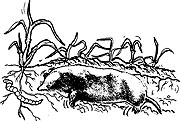Most rodents manage to get a bad rap, but none are more unfairly framed than the lower-than-lowly mole. The worst abuse is meted out by keepers of pool-table-perfect lawns who wail and gnash their teeth when tunnels appear overnight, sudden wrinkles in their putting-green dreamscapes.

illustration courtesy N.C. State University
|
Out come the spring-loaded shish-kebab traps, poison gas and ultrasonic repellers, not to mention those weighted rollers that bludgeon the landscape into respectability once more. (Did I mention chewing gum? Supposedly, moles love to eat Juicy Fruit gum, unaware that it will cause terminal constipation. Sounds highly doubtful to me, but then I’ve never been a gum chewer, so what do I know?)
“Set out traps at the first sign of tunnels,” even as generally enlightened an author as Tanya Denckla decreed in her indispensable handbook, The Gardener’s A-Z Guide to Growing Organic Food (Storey Publishing, 2003).
Oh Tanya, Tanya! You are usually so much more reasonable.
For a rational approach to these paddle-footed, pink-nosed friends, it’s better to turn to Steven Carroll and Steven Salt, whose Ecology for Gardeners (Timber Press, 2004) delivers this rejoinder: “Before resorting to such measures, gardeners may want to weigh the damage moles do against the huge number of harmful insects that they eat, especially larvae of garden pests such as Japanese beetles.”
Duh.
Of course moles may disturb some plant roots, perhaps even toppling the occasional young plant, but they are only chugging around (running nearly blind, I might add) looking for grubs that would otherwise morph into hordes of beetles that turn foliage to lace. And yes, Tanya, they do eat some earthworms. But if the soil is rich and loamy and supplied with ample organic matter, there are lots more earthworms whence those came.
Furthermore, mole tunnels permit rainwater to penetrate deeply, rather than simply running off. This is what is known as a benefit.
The real garden enemies amongst the order Rodentia are generally larger and limit their tunneling to home construction. Groundhogs, which have appetites to match their names, can wipe out dozens of plants in one sitting, while squirrels deplete fruit-and-vegetable crops in no time and exhibit a healthy appreciation for ripening corn. Although native mice and rats are relatively benign, their Old World counterparts are invaders from hell. The Norway rat, black rat and house mouse inflict extraordinary damage on all that true Americans hold dear, burrowing into food repositories, stored sweaters, stuffed furniture, insulation, fruits, nuts, vegetables, blankets and mattresses — stripping bark from trees, dragging babies from their cribs, and gnawing the feet of commuters awaiting buses and trains.
Shrews — those pointy-nosed, voraciously carnivorous cousins — are entirely beneficial, eating nearly any critter that holds still long enough to be swallowed (mostly bad guys).
If Noah had needed to resolve a crowding problem, he would have done well to force the Old World rats to walk the plank in midvoyage. As it happened, they hitched rides on sailing ships and didn’t abandon ship until they were on this side of the big pond, where they spread like mad.
Too often, moles are confused with their alliterative kin, the voles, who are only marginally less harmful than their Old World teammates. Voles sometimes strip bark from fruit trees, completely girdling and killing them. They eat hay and grain crops and consume numerous flower bulbs. The meadow vole, found throughout the cool regions of this continent (from the Appalachians and Ozarks on north), is a rascal and not to be trusted with the family car, much less the tender nibblies in the family garden.
There are three species of moles in our region, all equally beneficial. The eastern mole is the largest, growing up to 6-1/2 inches in length, while the star-nosed and hairy-tailed moles are an inch shorter. Both names are self-explanatory. The former critter — unique among mammals — boasts an unusual nasal opening with 22 fingerlike tentacles, rather like a sea anemone. The latter has, yes, a hairy tail.
In short — and there’s really nothing long about moles, other than their tunnels — these are garden buddies. Be kind.



Before you comment
The comments section is here to provide a platform for civil dialogue on the issues we face together as a local community. Xpress is committed to offering this platform for all voices, but when the tone of the discussion gets nasty or strays off topic, we believe many people choose not to participate. Xpress editors are determined to moderate comments to ensure a constructive interchange is maintained. All comments judged not to be in keeping with the spirit of civil discourse will be removed and repeat violators will be banned. See here for our terms of service. Thank you for being part of this effort to promote respectful discussion.